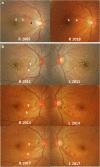Health screening program revealed risk factors associated with development and progression of papillomacular bundle defect
- PMID: 33786089
- PMCID: PMC7954962
- DOI: 10.1007/s13167-021-00235-4
Health screening program revealed risk factors associated with development and progression of papillomacular bundle defect
Abstract
Background/aims: The papillomacular bundle (PMB) area is an important anatomical site associated with central vision. As preventive medicine and health screening examinations are now becoming commonplace, the incidental detection of papillomacular bundle defect (PMBD) on fundus photography has been increasing. However, clinical significance of incidental PMBD has not been well documented to date. Thus, through long-term and longitudinal observation, we aimed to investigate the risk factors for the development and progression of PMBD and its predictive role associated with systemic diseases and glaucoma.
Methods: This longitudinal study included subjects who had undergone standardized health screening. We retrospectively reviewed patients for whom PMBD had been detected in fundus photography and followed up for more than 5 years. For a comparative analysis, non-PMBD groups of age- and gender-matched healthy controls were selected.
Results: A total of about 67,000 fundus photographs were analyzed for 8.0 years, and 587 PMBD eyes were found. Among them, 234 eyes of 234 patients who had had fundus photographs taken for more than 5 years were finally included. A total of 216 eyes (92.3%) did not progress during the 8.1 ± 2.7 years, whereas 18 eyes (7.7%) showed progression at 7.6 ± 2.9 years after initial detection. A multivariate logistic regression analysis using 224 non-PMBD healthy controls revealed low body mass index (BMI < 20 kg/m2), systemic hypertension, and sclerotic changes of retinal artery as the significant risk factors for the development of PMBD. Regarding PMBD progression, low BMI, concomitant retinal nerve fiber layer defect (RNFLD) at non-PMB sites, optic disc hemorrhage, and higher vertical cup/disc ratio were individual significant risk factors.
Conclusion: PMBD is associated with ischemic effects. Although the majority of PMBD do not progress, some of cases are associated with glaucomatous damage in a long-term way. PMBD might be a personalized indicator representing ischemia-associated diseases and a predictive factor for diagnosis and preventive management of glaucoma.
Keywords: Cardiovascular disease; Disease development and progression; Glaucoma; Health screening examination; Ischemia-associated diseases; Longitudinal study; Low body mass index; Ophthalmology; Papillomacular bundle defect; Personalized indicator; Predictive factors; Predictive preventive personalized medicine (PPPM/3PM); Preventive management; Program; Risk assessment; Risk factors; Screening; Systemic effects and characteristics.
© European Association for Predictive, Preventive and Personalised Medicine (EPMA) 2021.
Conflict of interest statement
Conflict of interestThe authors declare no competing interests.
Figures





Similar articles
-
Papillomacular bundle defect (PMBD) in glaucoma patients with high myopia: frequency and risk factors.Sci Rep. 2023 Dec 11;13(1):21958. doi: 10.1038/s41598-023-48687-0. Sci Rep. 2023. PMID: 38081858 Free PMC article.
-
Optic nerve head characteristics in eyes with papillomacular bundle defects in glaucoma.Int Ophthalmol. 2015 Dec;35(6):819-26. doi: 10.1007/s10792-015-0053-y. Epub 2015 Feb 27. Int Ophthalmol. 2015. PMID: 25721564
-
Ancillary PanoMap OCT shows the progression of glaucomatous papillomacular bundle defect with disc haemorrhage on the fovea-disc axis.Br J Ophthalmol. 2023 Nov;107(11):1630-1637. doi: 10.1136/bjo-2021-320642. Epub 2022 Aug 24. Br J Ophthalmol. 2023. PMID: 36002238
-
[A challenge to primary open-angle glaucoma including normal-pressure. Clinical problems and their scientific solution].Nippon Ganka Gakkai Zasshi. 2012 Mar;116(3):233-67; discussion 268. Nippon Ganka Gakkai Zasshi. 2012. PMID: 22568103 Review. Japanese.
-
[A new approach for studying the retinal and choroidal circulation].Nippon Ganka Gakkai Zasshi. 2004 Dec;108(12):836-61; discussion 862. Nippon Ganka Gakkai Zasshi. 2004. PMID: 15656089 Review. Japanese.
Cited by
-
Papillomacular bundle defect (PMBD) in glaucoma patients with high myopia: frequency and risk factors.Sci Rep. 2023 Dec 11;13(1):21958. doi: 10.1038/s41598-023-48687-0. Sci Rep. 2023. PMID: 38081858 Free PMC article.
-
Factors Associated with Visual Acuity in Advanced Glaucoma.J Clin Med. 2023 Apr 24;12(9):3076. doi: 10.3390/jcm12093076. J Clin Med. 2023. PMID: 37176517 Free PMC article.
-
Automated detection of nine infantile fundus diseases and conditions in retinal images using a deep learning system.EPMA J. 2024 Feb 15;15(1):39-51. doi: 10.1007/s13167-024-00350-y. eCollection 2024 Mar. EPMA J. 2024. PMID: 38463622 Free PMC article.
-
The correlation between primary open-angle glaucoma (POAG) and gut microbiota: a pilot study towards predictive, preventive, and personalized medicine.EPMA J. 2023 Aug 11;14(3):539-552. doi: 10.1007/s13167-023-00336-2. eCollection 2023 Sep. EPMA J. 2023. PMID: 37605653 Free PMC article.
-
Association between Serum Total Bilirubin Level and Patients with Primary Open-Angle Glaucoma in China: A Cross-Sectional, Case-Control Study.Oxid Med Cell Longev. 2023 Jan 19;2023:8206298. doi: 10.1155/2023/8206298. eCollection 2023. Oxid Med Cell Longev. 2023. PMID: 36718279 Free PMC article.
References
-
- Beaglehole R, Bonita R, Horton R, Adams C, Alleyne G, Asaria P, Baugh V, Bekedam H, Billo N, Casswell S, Cecchini M, Colagiuri R, Colagiuri S, Collins T, Ebrahim S, Engelgau M, Galea G, Gaziano T, Geneau R, Haines A, Hospedales J, Jha P, Keeling A, Leeder S, Lincoln P, McKee M, Mackay J, Magnusson R, Moodie R, Mwatsama M, Nishtar S, Norrving B, Patterson D, Piot P, Ralston J, Rani M, Reddy KS, Sassi F, Sheron N, Stuckler D, Suh I, Torode J, Varghese C, Watt J. Priority actions for the non-communicable disease crisis. Lancet. 2011;377(9775):1438–1447. doi: 10.1016/S0140-6736(11)60393-0. - DOI - PubMed
LinkOut - more resources
Full Text Sources
Other Literature Sources
Research Materials

